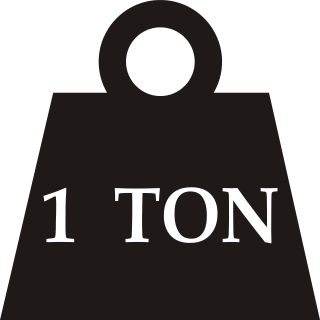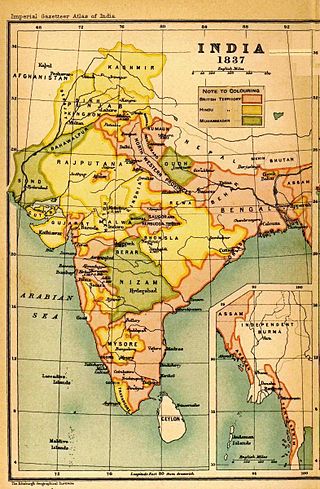Related Research Articles

The pound or pound-mass is a unit of mass used in both the British imperial and United States customary systems of measurement. Various definitions have been used; the most common today is the international avoirdupois pound, which is legally defined as exactly 0.45359237 kilograms, and which is divided into 16 avoirdupois ounces. The international standard symbol for the avoirdupois pound is lb; an alternative symbol is lbm, #, and ℔ or ″̶.

Ton is any of several units of measure of mass, volume or force. It has a long history and has acquired several meanings and uses.

United States customary units form a system of measurement units commonly used in the United States and most U.S. territories, since being standardized and adopted in 1832. The United States customary system developed from English units that were in use in the British Empire before the U.S. became an independent country. The United Kingdom's system of measures was overhauled in 1824 to create the imperial system, which was officially adopted in 1826, changing the definitions of some of its units. Consequently, while many U.S. units are essentially similar to their imperial counterparts, there are noticeable differences between the systems.
The ounce is any of several different units of mass, weight, or volume and is derived almost unchanged from the uncia, an Ancient Roman unit of measurement.

Avoirdupois is a measurement system of weights that uses pounds and ounces as units. It was first commonly used in the 13th century AD and was updated in 1959.

A bushel is an imperial and US customary unit of volume based upon an earlier measure of dry capacity. The old bushel is equal to 2 kennings (obsolete), 4 pecks, or 8 dry gallons, and was used mostly for agricultural products, such as wheat. In modern usage, the volume is nominal, with bushels denoting a mass defined differently for each commodity.

La Pinta was the fastest of the three Spanish ships used by Christopher Columbus in his first transatlantic voyage in 1492. The New World was first sighted by Rodrigo de Triana aboard La Pinta on 12 October 1492. The owner of La Pinta was Cristóbal Quintero. The Quintero brothers were ship owners from Palos. The owner of the ship allowed Martín Alonso Pinzón to take over the ship so he could keep an eye on it.
The apothecaries' system, or apothecaries' weights and measures, is a historical system of mass and volume units that were used by physicians and apothecaries for medical prescriptions and also sometimes by scientists. The English version of the system is closely related to the English troy system of weights, the pound and grain being exactly the same in both. It divides a pound into 12 ounces, an ounce into 8 drachms, and a drachm into 3 scruples of 20 grains each. This exact form of the system was used in the United Kingdom; in some of its former colonies, it survived well into the 20th century. The apothecaries' system of measures is a similar system of volume units based on the fluid ounce. For a long time, medical recipes were written in Latin, often using special symbols to denote weights and measures.
A system of units of measurement, also known as a system of units or system of measurement, is a collection of units of measurement and rules relating them to each other. Systems of measurement have historically been important, regulated and defined for the purposes of science and commerce. Instances in use include the International System of Units or SI, the British imperial system, and the United States customary system.
The tun is an English unit of liquid volume, used for measuring wine, oil or honey. Typically a large vat or vessel, most often holding 252 wine gallons, but occasionally other sizes were also used. The modern tun is about 954 litres.

Victoria or Nao Victoria was a carrack famed as the first ship to successfully circumnavigate the world. Victoria was part of the Spanish expedition to the Moluccas commanded by the explorer Ferdinand Magellan.
Trinidad was the flagship of Ferdinand Magellan's voyage of circumnavigation. Unlike Elcano's Victoria, which returned to Spain sailing across the Indian Ocean, Trinidad tried and failed to sail east across the Pacific to New Spain or modern-day Mexico. Trinidad was a nao (ship) of 100 or 110 tonels with square sails on the fore and main masts and a lateen mizzen. Its original crew was 61. After Magellan's death and the burning of the Concepcion, Victoria and Trinidad reached Tidore on 8 November 1521. In mid-December both ships attempted to depart loaded with cloves, but Trinidad almost immediately began to leak badly. Inspection showed that the problem was serious. It was agreed that Victoria would leave for Spain and Trinidad would remain for repairs.

The candy or candee, also known as the maunee, was a traditional South Asian unit of mass, equal to 20 maunds and roughly equivalent to 500 pounds avoirdupois (227 kilograms). It was most used in southern India, to the south of Akbar's empire, but has been recorded elsewhere in South Asia. In Marathi, the same word was also used for a unit of area of 120 bighas, and it is also recorded as a unit of dry volume.

The Descubierta and Atrevida were twin corvettes of the Spanish Navy, custom-designed as identical special exploration and scientific research vessels. They were built at the same time for the Malaspina Expedition. Under the command of Alejandro Malaspina (Descubierta) and José de Bustamante y Guerra (Atrevida) the two vessels sailed from Spain to the Pacific Ocean, conducting a thorough examination of the internal politics of the American Spanish Empire and the Philippines. They explored the coast of Alaska and worked to reinforce Spain's claim to the Pacific Northwest in the aftermath of the Nootka Crisis. After crossing the Pacific Ocean, the colonial government in the Philippines was examined. Exploration and diplomatic reconnaissance followed, with stops in Qing dynasty-era China, New Zealand, Australia, and Tonga.
The quarter was used as the name of several distinct English units based on ¼ sizes of some base unit.
The load, also known as a fodder, fother, and charrus, is a historic English unit of weight or mass of various amounts, depending on the era, the substance being measured, and where it was being measured. The term was in use by the 13th century, and disappeared with legislation from the 1820s onwards. Modern equivalents of historical weights and measures are often very difficult to determine, and figures given here should be treated with caution.
A number of different units of measurement were used in Argentina as its national system was derived from Spanish Castillian. The metric system was legally optional since 1863 and has been compulsory since 1887.
A number of different units of measurement were used in Brazil to measure quantities including length, area, volume, and mass as those units were derived from Portugal and had significant local variances.
A number of units of measurement were used in South Africa to measure quantities like length, mass, capacity, etc. The Imperial system of measurements was made standard in 1922 and the metric system was adopted in 1961.
The Concepción was an early-16th-century Spanish carrack during the Age of Discovery, chiefly remembered as part of the Molucca Fleet that made up the 1519–1522 Magellan–Elcano expedition that attempted to find a Southwestern Passage around South America to the Spice Islands and subsequently completed the first circumnavigation of the globe. The Concepción itself did not complete the journey, needing to be scuttled in the Philippines in 1521.
References
Citations
- ↑ Walls y Merino (1899), p. 174.
- 1 2 3 Jackson (1882) , p. 177.
- ↑ Phillips et al. (1992), p. 291.
- 1 2 Phillips (1990), p. 78
- ↑ Chaunu et al. (1955–1960).
- ↑ Morineau (1966), pp. 31–34, 64, 115–116.
- ↑ Phillips (2015), p. 188.
- ↑ Andrews (1984), p. 231.
- 1 2 3 Jackson (1882) , p. 236.
- 1 2 Jackson (1882) , p. 237.
Bibliography
- Andrews, Kenneth R. (1984), Trade, Plunder, and Settlement: Maritime Enterprise and the Genesis of the British Empire, 1480–1630, Cambridge: Cambridge University Press, ISBN 9780521276986 .
- Chaunu, Pierre; et al. (1955–1960), Séville et l'Atlantique, 1504–1650 (in French), Paris
{{citation}}: CS1 maint: location missing publisher (link). - Jackson, Lowis d'Agullar (1882), Modern Metrology..., London: Crosby, Lockwood, & Co.
- Lane, Frederic C. (1964). "Tonnages, Medieval and Modern". The Economic History Review. 17 (2): 213–233. ISSN 0013-0117. JSTOR 2593003.
- Morineau, Michel (1966), Jauges et Méthodes de Jauge Anciennes et Modernes (in French), Paris
{{citation}}: CS1 maint: location missing publisher (link). - Phillips, Carla Rahn (1990), "The Growth and Composition of Trade in the Iberian Empires, 1450–1750", The Rise of Merchant Empires: Long-Distance Trade in the Early Modern World, 1350–1750, Cambridge: Cambridge University Press, pp. 34–173, ISBN 9780521457354 .
- Phillips, Carla Rahn (2015), "Spanish Mariners in a Global Context", Law, Labour, and Empire: Comparative Perspectives on Seafarers, c. 1500–1800, Basingstoke: Palgrave Macmillan, ISBN 9781137447463 .
- Phillips, William D. Jr.; et al. (1992), The Worlds of Christopher Columbus, Cambridge: Cambridge University Press, ISBN 9780521446525 .
- Walls y Merino; et al., eds. (1899), "Anexo Núm. 3: Porte de las Naos y Su Costo...", Primer Viaje Alrededor del Mundo... (PDF) (in Spanish), Madrid, pp. 174–184
{{citation}}: CS1 maint: location missing publisher (link).